Understanding Ring Sizes in the United States
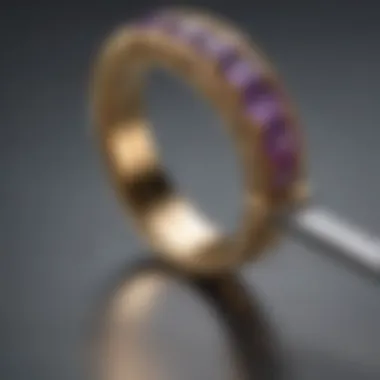
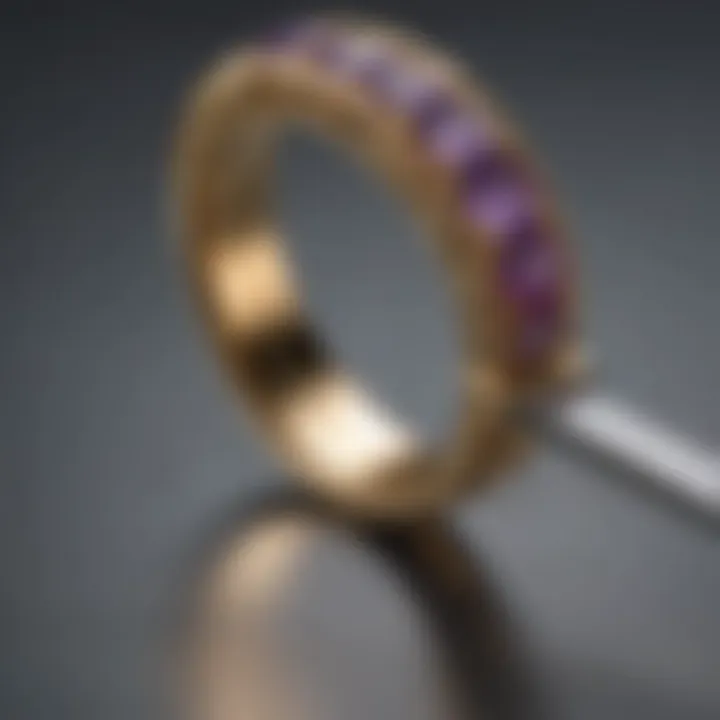
Intro
Understanding ring sizes can sometimes feel like navigating a maze. In the United States, where preferences vary broadly due to cultural nuances and individual choices, the sizing can be a puzzle, especially for those new to purchasing jewelry. This exploration dives deeply into the aspects of ring sizes, covering everything from the most common sizes available on the market to the various methods of accurately determining one’s size.
As we embark on this journey, it’s crucial to highlight how a simple measurement can have profound implications, not only for the person wearing the ring but also for jewelers and designers. A well-fitted ring can signify commitment, celebration, or personal style, while an ill-fitting one might lead to discomfort, dissatisfaction, or even loss.
Moreover, the world of ring sizes is not solely a numeric system; it transcends into social influences, trends, and even historical habits. This article sets out to paint a comprehensive picture that can serve as a guide for novices and connoisseurs alike. With this in mind, we delve directly into the key discussions that will shape our understanding of ring sizes and their impact on the jewelry industry.
Understanding Ring Sizes
In the realm of jewelry, especially when it comes to rings, understanding sizes is more than just a trivial matter. It represents a fundamental aspect of personal adornment that transcends mere aesthetics. Getting the size right is vital, as an ill-fitting ring can lead to discomfort or even loss. This significance highlights the need for individuals to comprehend the measurement system used in their country, particularly in the United States.
Accurate ring sizing encompasses a variety of elements. For one, it affects buyer satisfaction; a perfectly sized ring contributes to a positive experience while wearing it. Furthermore, it influences design choices and customization options for jewelers. When understanding ring sizes, factors such as width, thickness, and one's finger shape come into play, each contributing to a unique wear experience.
The topic becomes particularly relevant not only for those purchasing rings but also for those who create them. Jewelers engage in a delicate dance, balancing aesthetics with function. They often explain how accurate sizing can prevent future adjustments, which can sometimes weaken the integrity of the piece. Moreover, familiarity with sizes enables collectors and enthusiasts to appreciate the nuances of the craft.
"A well-fitted ring tells a story of its own, one of careful consideration and style."
In summary, understanding ring sizes is crucial not just for ensuring a snug fit, but also for enriching the connection individuals have with their jewelry. It creates a bridge between art and personal expression, establishing a deeper appreciation for the charm that rings can bring to one’s life.
The Basics of Ring Sizing
When it comes to determining a ring size, it often feels like navigating a maze. In the United States, the traditional sizing system employs an alphanumeric approach. Each size is represented as a number and/or letter, ranging generally from sizes 3 to 13. Each increment corresponds roughly to a 0.032-inch increase in diameter, which can be quite significant when decisions are made based on comfort.
To properly measure, most people will resort to a few different methods. Some prefer to use a ring sizer tool which includes a series of metal or plastic sizing rings, allowing one to try them on until they find the perfect fit. Others might take a piece of string or paper, wrap it around their finger, and measure the length against a ruler.
However, it's advised to measure fingers at room temperature. Fingers often swell or shrink with temperature changes, making it essential to time the measurement correctly.
Importance of Accurate Sizing
Accurate sizing may seem like a small detail, but it bears significant weight in the world of jewelry. Many individuals have shared stories where a simply-sized ring went wildly wrong, leading to awkward moments or even lost treasures.
The importance of precision cannot be overstated, especially when placing orders for special events such as engagements or weddings. A ring representing such milestones deserves to fit just right; otherwise, it could detract from the occasion.
In particular, there are several implications of inaccurate sizing:
- Comfort: An improperly sized ring can pinch or slide off, leading to discomfort for the wearer.
- Aesthetics: Rings that fit loosely can shift, obscuring intricate designs or gemstones meant to shine.
- Emotional Value: Rings often carry sentimental weight, especially those passed down generations. If the size isn't accurate, it diminishes their significance.
Popular Ring Sizes in the US
Understanding the landscape of popular ring sizes in the United States is akin to deciphering a well-kept secret among jewelers and buyers alike. This section sheds light on the significance of sizes, which can affect aesthetic choices and the heart's intent whether it’s a token of love, an expression of personal style, or a symbol of commitment. Choosing the right size is not just a matter of comfort; it's about making a statement.
Overview of Common Sizes
When it comes to rings, size truly matters. In the U.S., ring sizes generally range from about 3 to 13. Most women typically gravitate towards sizes 5 to 8, while men's sizes hover around 7 to 12. It’s interesting to note that there’s no one-size-fits-all rule, and individual preferences vary greatly.
To break it down further:
- Women’s Sizes: Commonly, sizes 6 and 7 are the most frequently purchased, known as the ‘average’ sizes.
- Men’s Sizes: Size 10 stands out as the most popular among men's rings.
People often think rings meant for formal occasions like engagements or weddings would come in standardized sizes, however, trends show that many choose custom sizing to better reflect their personal flair.
Another notable point is that ring sizes can have serious implications for materials and designs. For instance, a thicker band typically feels snugger than a slim one, meaning that one might need to adjust their size accordingly. This subtlety serves as a reminder that individuals should be aware of how size intertwines with style and comfort.
Distribution of Sizes by Gender
A deeper look at how ring sizes distribute across genders reveals intriguing patterns. On average, multi-dimensional factors come into play.
- Women: They often choose rings based not just on size but personal and emotional significance. Whether the rings are for casual daily wear or special occasions, size becomes essential. Notably, women often wear stacked rings, which can make size calculations a bit dicey. In such cases, average sizes seem to sway between 6 and 8, but a certain brand or style might lean a size up or down based on design preferences.
- Men: Men’s choices tend to be more straightforward. The traditional stance that rings mean commitment leads to larger sizes than casual pieces. A notable trend is the increasing popularity of broader rings, where sizes often shift towards 11 and 12.
The significant lesson here is that a buyer's motivation often influences their choice of size. Those seeking a passionate token may sacrifice personal comfort for an eye-catching design, while others may prioritize wearability above all else.
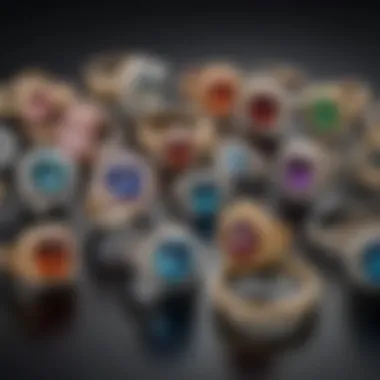
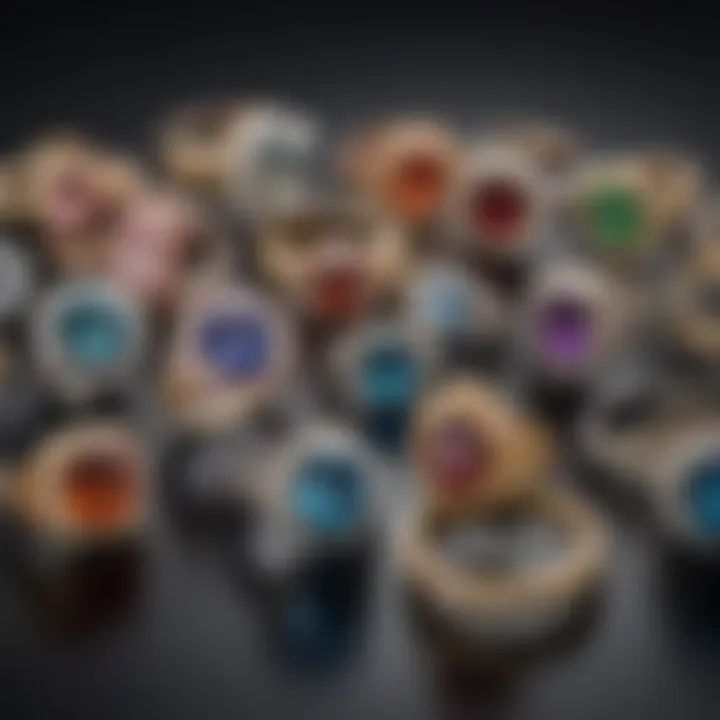
In summary, the realm of popular ring sizes in the U.S. brings together individual taste, cultural influences, and the nature of the occasion to craft a deeply personal experience. For gemstone enthusiasts and jewelry designers, understanding these size dynamics opens avenues for creativity and connection with clients.
Measuring Ring Size Accurately
Accurate ring sizing is a pivotal aspect in the realm of jewelry, particularly for those seeking to mark significant milestones such as engagements or weddings. Getting the right size ensures that the ring not only fits comfortably but also complements the wearer's style. A poorly fitting ring can lead to discomfort, loss, or even a tarnished emotional significance attached to the piece. Simply put, knowing how a slight variation in measurement can alter the fit makes all the difference.
Tools for Measuring
When it comes to determining ring size, having the right tools can make the process seamless. Various instruments can aid in achieving a precise measure, including:
- Ring Sizer: Available in plastic or metal, this tool allows individuals to try on digital-sized hoops to find the right fit.
- Measuring Tape: A flexible tape can be wrapped around the finger for a snug measurement.
- String: Cut a piece of string, wrap it around the base of the finger, and mark the overlap for accurate measurement.
- Printable Ring Sizer: Many jewelers offer downloadable templates which can be printed at home for a DIY approach.
Each of these tools serves a unique purpose and can help in double-checking measurements for peace of mind.
Guide to Home Measurement Techniques
Measuring ring size at home can be done effectively using simple methods. While this might seem straightforward, a bit of care ensures accurate results. Here’s how to do it right:
- Select the Correct Time: It's best to measure fingers at the end of the day when they’re at their largest due to warmth.
- Use the Right Method:
- Check Fit Across Fingers: Remember that different fingers may require differing sizes, so be sure to measure the specific one intended for the ring.
- String Measurement: As mentioned earlier, wrap a piece of string around the finger and mark where it meets. Measure the length of the string in millimeters to find your size.
- Comparison with an Existing Ring: If you have a well-fitting ring, measure its inner diameter with a ruler. Use the corresponding size chart to find your size.
Tip: Avoid using elastic bands; they can stretch and give inaccurate readings.
When to Seek Professional Help
Even with the best home strategies, there are moments when consulting a professional is advisable. Consider reaching out to jewelry experts when:
- Uncertainty Arises: If there’s doubt over measurements or complications arise, a jeweler can provide clarity.
- Perfect Sizing is Crucial: For special occasions like engagements, seeking help can ensure the utmost precision.
- Adjustments Needed: If the ring needs resizing after purchase, professional input can simplify the task, especially for rings with intricate designs.
In summary, while DIY methods for measuring ring sizes can yield satisfying results, the delicate nature of jewelry often necessitates a professional touch, ensuring that cherished pieces fit perfectly.
Cultural Influences on Ring Sizes
Understanding the cultural contexts surrounding ring sizes provides a holistic view into how their meaning and significance shape preferences among consumers. These influences can vary significantly based on personal beliefs, traditions, and societal norms. Recognizing these cultural nuances not only helps individuals select the right size but also leads jewelers to cater to diverse populations more effectively. This segment will delve into the historical context and explore regional variations that can affect ring size choices.
Historical Context of Ring Sizes
The history of ring sizes is interwoven with the evolution of jewelry itself. In ancient times, rings were often crafted from materials readily available and were typically made to fit the wearer as closely as possible, without the intricate sizing tools that jewelers use today. Early Egyptians, for example, used rings as symbols of fidelity and status, often making them adjustable to fit different fingers.
The Renaissance period marked a shift in ring creation, where a greater variety of sizes and designs emerged. This era saw a surge of craftsmanship that emphasized intricate settings for gemstones, but the focus on accurate sizing was still not prevalent. It was not until the late 19th century that formal sizing systems began to emerge, thanks to innovations in manufacturing and materials. The introduction of the United States sizing chart standardized ring sizes, which allowed for a greater accessibility in acquiring rings.
Understanding this historical progression is crucial for appreciating how cultural attitudes toward rings have also changed. For instance, during periods of economic hardship, simpler rings that could still denote commitment became popular. Additionally, as women's roles evolved in society, so too did their preferences for ring styles and sizes.
Regional Variations in Preferences
Just as cultural backgrounds shape people's views on jewelry, regional variances play a significant role in shaping ring size preferences across the United States. The preferences for certain styles or sizes can sometimes overlap with cultural identities.
- Northeast: In urban areas such as New York and Boston, many people gravitate toward contemporary and minimalistic styles. Engagement rings often showcase larger center stones and intricate settings, sometimes emphasizing unique shapes over size.
- South: Southern traditions often celebrate grandeur. Rings in this region tend to be more ornate, with larger stones and a focus on family heirlooms that are passed down through generations. It’s common to see multi-stone arrangements or intricate designs that tell a story.
- West Coast: The West embraces individualism. There is a notable trend towards alternative engagement rings, with many opting for ethically sourced or unconventional gemstones that still come in a variety of sizes. There’s a good mix of both minimal and maximal preferences here.
- Midwest: Known for practicality, many prefer classic designs that stand the test of time. Rings tend to be simple yet sturdy.
The preferences across regions exemplify how cultural legacies feed into the choices people make regarding not just the aesthetics, but sizing as well. Not to mention, the impact of social media has started to cloud traditional sizes with more modern, trend-driven choices.
"The size of a ring isn't just a number; it's tied into histories, traditions, and expectations that vary from one corner of the United States to another."
By delving into the cultural influences shaping ring sizes—from historical perspectives to regional preferences—this article underscores the importance of understanding diverse factors at play. This awareness is vital for jewelers aiming to meet consumer needs and for individuals hoping to choose their rings with familiarity and confidence.
Ring Size Considerations for Special Occasions
Selecting the right ring size for special occasions is of utmost importance, not just for aesthetics but also for comfort and meaningfulness. Different milestones in life, like engagements, weddings, and anniversaries, serve as moments of significance – they merit a personal touch, especially when it comes to the rings that symbolize love and commitment.
When choosing a ring size, one must consider not only the finger measurements but also the style, design, and the moment itself. An accurate ring size can enhance the experience, ensuring that the piece of jewelry sits snugly yet comfortably without causing any irritation.


Engagement Rings
Engagement rings are perhaps the most scrutinized of all ring types. They carry not only the weight of commitment but often the immense emotional significance of the promise to marry. When selecting an engagement ring, precise measurement is critical. Factors such as time of year, finger size fluctuations, and finger shape can all impact the size choice.
A poorly sized engagement ring can lead to discomfort, loss, or even damage to the ring. It’s advisable to size the ring in a calm moment.
Many choose to secretly gauge their partner's ring size without them knowing. This can involve asking friends or family about their sizes, or even borrowing a ring to take to the jeweler. But if you know your significant other’s size from past experiences, you should double-check it. Fingers can change over time for various reasons like weight gain, loss, or temperature.
Wedding Bands
Wedding bands symbolize an unbroken circle of love. The fit of a wedding band should not only complement the engagement ring but also ensure comfort on the big day and beyond. Typically, couples consider how they will wear both rings together. Hence, choosing the right size is vital.
When considering a wedding band, remember that lifestyle matters. For someone who uses their hands frequently, a snug fit might be ideal to prevent the ring from slipping off. Alternatively, for someone not used to wearing jewelry, a fit that offers some wiggle room could be less irritating. You can’t just toss a ring on; it has to feel right.
Anniversary Rings
Anniversary rings are often given to commemorate years spent together. These rings can take on various forms, such as additional bands that stack with existing ones, or even a brand new piece. The importance here is that they evoke feelings akin to those tied to both engagement and wedding rings.
When choosing an anniversary ring, it’s essential to reconsider past measurements. Many people find their fingers change slightly with the seasons or time, which can alter the fit of even a well-loved piece. A thoughtful approach involves not just measuring the finger but also reflecting on what has been worn comfortably in the past.
Impacts of Ring Size on Design Choices
When it comes to ring design, size plays a pivotal role that can’t be overlooked. The relationship between ring size and design choices can significantly affect both the aesthetics and the practicality of the piece. Designers must consider various elements ranging from artistry to wearability, ensuring that the end result captivates while functioning well.
Choosing Settings Based on Size
The size of a ring has a direct impact on the type of setting a designer can utilize. For larger sizes, especially those above a certain threshold, more substantial settings tend to not just highlight the stone but also balance the overall appearance of the ring. A petite setting might get lost on a larger finger, while smaller settings on larger rings could seem out of place.
For example, a delicate solitaire diamond might look stunning on a size 5 finger but appear dwarfed on a size 8 finger. Conversely, for a size 10 ring, a more elaborate halo setting can sparkle and catch the eye effectively, complementing the larger dimensions of the finger.
"The beauty of a ring lies not only in its stones but also in how well it suits the finger it adorns."
In choosing the right setting, designers should also weigh the type of gemstone involved. Some stones can appear bulkier and need a setting that enhances their natural qualities. Meanwhile, more fragile stones like opals may require protective settings, ensuring the stone remains secure while still showcasing its natural beauty.
Width and Thickness Influences
Another critical aspect of ring design influenced by size is the width and thickness of the band itself. A wider band typically conveys a bold and statement-making appearance, but it may not be suitable for everyone. For instance, a size 6 finger may feel comfortable with a band width of 3mm to 5mm, while someone with a larger size 10 finger might prefer widths between 6mm to 8mm.
The thickness also correlates with the style. Thinner bands lend a more delicate and vintage vibe, often resonating well with those who prefer subtlety. In contrast, thicker bands can offer a sense of sturdiness and presence, usually appealing to those who favor a statement-making piece. For an engaging and functional ring design, understanding the wearer’s finger size for band width is essential.
Some key factors to consider when deciding on width and thickness include:
- Comfort: A thicker band on a smaller finger may feel restrictive or even uncomfortable.
- Style: Personal aesthetic preferences will dictate whether one leans towards bold and wide designs or understated narrow ones.
- Balance: Striking a balance between the size of the ring’s center stone and the band ensures the overall design looks harmonious.
Trends in Ring Sizing
Understanding the latest trends in ring sizing is crucial for anyone involved in the realm of jewelry, whether you are a buyer, seller, or designer. These trends can speak volumes about personal preferences, market demands, and even social attitudes towards jewelry.
As the tastes and preferences of consumers evolve, so does the landscape of ring sizes. What was once considered the norm may soon give way to burgeoning trends that cater to a younger demographic or highlight changing cultural attitudes about engagement and fashion. This section will explore emerging size preferences and the undeniable influence of social media.
Emerging Size Preferences
In recent years, there has been a noticeable shift away from standard ring sizes. The shift reflects not just individuality but also an evolving understanding of comfort and aesthetics in jewelry design. Many people are gravitating towards unique sizes that align more closely with personal identity and lifestyle choices.
- Custom Sizes: Options for custom sizing are becoming more commonplace. Custom sizes are tailored to the individual, moving away from mass-market solutions. The result? Rings that fit perfectly and resonate on a personal level.
- Unisex Sizes: There has been a marked rise in the popularity of unisex rings which accommodate various styles and preferences. This trend represents a broader cultural movement towards inclusivity in fashion, blurring traditional gender norms in jewelry.
- Variations in Diameter: Unlike in past decades, where size charts dictated common sizes, newer models often focus on varying diameters, prioritizing different finger shapes and widths. This advancement allows for a tailor-made look that others might not find.
"In jewelry, size is often about more than just numbers; it's a reflection of one's identity and style."
This whirlwind of emerging preferences reflects a desire for more customization and personal touches. The fact that individuals now seek what fits and feels right for them, rather than conforming to a one-size-fits-all approach, speaks to a deeper desire for authenticity.
Influence of Social Media

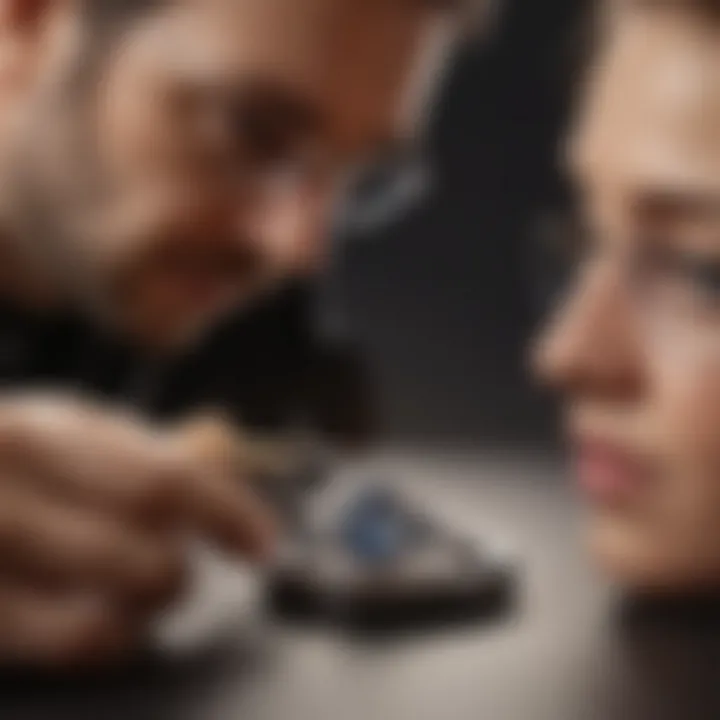
Social media platforms have undoubtedly transformed how the world perceives and purchases jewelry. In the age of Instagram and TikTok, influencers showcase rings that pop off the screen, creating new standards of beauty and size preferences that extend beyond traditional confines.
- Visual Appeal: With social media being heavily visual, the aesthetics of rings play a determining role in consumer interest. Users are drawn to unique styles often depicted in selfies or curated feeds, leading to a preference for non-traditional sizes that stand out.
- Viral Trends: Hashtags and challenges proliferate throughout these networks. Trends can go viral; a particular size or style can gain explosive popularity overnight simply due to an influencer's post or a social media challenge.
- Consumer Feedback: Social media allows for immediate feedback on designs and trends. Jewelers and designers who actively engage with their clientele on these platforms can better understand public interest and adjust their products accordingly.
In this way, social media acts as both a conduit and a catalyst for changes in consumer preferences. People are not just buying rings; they are curating their identities through these purchases, influenced heavily by perceptions shaped online.
Overall, trends in ring sizing do not merely reflect changes in numbers but encapsulate a cultural narrative that is evolving. By observing what's being worn and shared online, anyone interested in jewelry can glean insights into the shifting perceptions about beauty, identity, and craftsmanship.
For more insights, visit Wikipedia or check discussions on Reddit.
Addressing Common Sizing Issues
When it comes to rings, especially engagement and wedding bands, many individuals find themselves puzzled by sizing issues. This aspect of ring sizing can make a significant difference in comfort and wearability. Understanding these common sizing challenges not only ensures a better fit but also impacts the overall experience with the piece of jewelry.
Adjusting Sizing for Comfort
Adjusting a ring's size is often necessary. However, it’s not merely about making it fit; comfort plays a vital role. A ring should feel like a natural extension of the finger. An ill-fitting ring can cause discomfort or even lead to health issues, such as skin irritation or circulation problems. Many people overlook this, rushing into a purchase without trying the ring on properly.
Some of the primary considerations when adjusting sizing include:
- Width of the band: Wider bands can feel tighter even if sized correctly. If you have a broader band, you might want to consider going up a half size for comfort.
- Your lifestyle: Do you have an active job or enjoy sports? If so, that might influence how tight or loose you want the ring to be.
- Time of day: Fingers can swell throughout the day depending on heat, activities, or fluid intake. This variation matters when determining a comfortable fit.
It’s beneficial to visit a jeweler for adjustments, especially if the ring needs resizing. For those who prefer to do it on their own, some tricks can be found on forums like Reddit, where users share experiences and tips on resizing and comfort adjustments.
Changing Sizes: Pros and Cons
Changing the size of a ring has its share of benefits and drawbacks. Here’s a closer look at both sides of the coin:
Pros:
- Customized Comfort: Altering a ring size ensures that it fits perfectly, which can enhance the overall wearing experience.
- Versatility: If your finger size changes (due to weight gain or loss, for instance), adjusting the size allows you to continue wearing rings that have sentimental value.
- Increased Usability: Properly sized rings can be more functional, making it easier to take on and off if needed.
Cons:
- Potential for Damage: Some rings, particularly those with intricate designs or stones, might be damaged during resizing. It’s crucial to choose a skilled jeweler who understands the intricacies of the piece.
- Cost Involvement: Resizing isn’t always free. Depending on the complexity and the materials used, you might end up paying a sizable fee, which could be frustrating, particularly if you’re on a budget.
- Misinterpretation of Size: It’s possible for the jeweler to misread the size. This can result in either too loose or too tight a fit.
In summary, addressing these common sizing issues plays a pivotal role in ensuring that jewelers and wearers alike are satisfied with the final product. Proper sizing, adjustments for comfort, and understanding the ramifications of changing sizes can make all the difference in the world.
Culmination
Understanding ring sizes is much more than just finding the correct fit for a finger; it intertwines with personal stories, significant milestones, and cultural appreciation. As explored throughout this article, accurately determining the right ring size affects not only the aesthetic appeal but also the comfort and emotional significance of the jewelry.
Key aspects to consider include:
- The importance of accurate sizing for functional wear and longevity.
- How variations in cultural preferences can dictate size choices across different demographics.
- The diverse methodologies available for measuring ring sizes, ensuring everyone has access to the necessary tools and information.
In many ways, a ring is not just a piece of adornment; it's a symbol of connection, commitment, or a cherished memory. By grasping the nuances of ring sizes within the American context, you empower yourself, whether as a buyer or jeweler, to make informed decisions that reflect individual taste as well as practical considerations.
"A ring might just be metal and stone, but the right size makes it feel like it belongs."
Furthermore, being cognizant of common sizing issues can mitigate future discomfort or dissatisfaction, allowing for a seamless experience in purchasing or creating jewelry. Seasoned individuals in the jewelry field recognize the value in not only understanding the facts and figures but also in appreciating the narrative behind each piece.
Recap of Key Insights
Throughout our exploration, several key insights emerged:
- Measurements Matter: Forgetting the fundamentals of measuring can result in frustration. Simple tools or professional assistance can resolve many sizing dilemmas.
- Cultural Dynamics: Preferences vary regionally and culturally, influencing what constitutes a popular size, especially among different gender groups.
- Flexibility is Essential: Knowing how to adjust sizes and understanding the pros and cons associated with resizing offers practical wisdom for buyers and designers alike.
- Trends Evolve: Ring sizes are not static and influence contemporary jewelry design, driven by societal changes and emerging preferences.
Each of these elements contributes to a richer understanding of ring sizing, one that goes beyond mere numbers and enters the realm of personal expression.
Final Thoughts on Ring Sizing
In summary, as jewelers and enthusiasts navigate the world of ring sizing, embracing a holistic understanding can be immensely beneficial. Accurate ring sizing enables both wearers and creators to appreciate the craftsmanship and meaning behind each piece.
Considering these points can enhance one's jewelry experience:
- Emphasize communication between buyers and jewelers to clarify sizing preferences and needs.
- Encourage exploration of the cultural aspects tied to ring sizes for a broader appreciation of their significance.
- Stay updated with trends that may influence size choices and preferences, particularly as social media plays an increasingly pivotal role in jewelry design and consumer attitude.
Ultimately, ring sizing involves an interplay of art, science, and emotion. Cultivating knowledge in this area does not just help in selecting the right size; it enriches the story that each ring has to tell.







